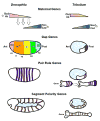Heads and tails: evolution of antero-posterior patterning in insects
- PMID: 18976722
- PMCID: PMC2700975
- DOI: 10.1016/j.bbagrm.2008.09.007
Heads and tails: evolution of antero-posterior patterning in insects
Abstract
In spite of their varied appearances, insects share a common body plan whose layout is established by patterning genes during embryogenesis. We understand in great molecular detail how the Drosophila embryo patterns its segments. However, Drosophila has a type of embryogenesis that is highly derived and varies extensively as compared to most insects. Therefore, the study of other insects is invaluable for piecing together how the ancestor of all insects established its segmented body plan, and how this process can be plastic during evolution. In this review, we discuss the evolution of Antero-Posterior (A-P) patterning mechanisms in insects. We first describe two distinct modes of insect development - long and short germ development - and how these two modes of patterning are achieved. We then summarize how A-P patterning occurs in the long-germ Drosophila, where most of our knowledge comes from, and in the well-studied short-germ insect, Tribolium. Finally, using examples from other insects, we highlight differences in patterns of expression, which suggest foci of evolutionary change.
Figures



Similar articles
-
Short and long germ segmentation: unanswered questions in the evolution of a developmental mode.Evol Dev. 2005 Nov-Dec;7(6):629-46. doi: 10.1111/j.1525-142X.2005.05066.x. Evol Dev. 2005. PMID: 16336416 Review.
-
Maternal torso signaling controls body axis elongation in a short germ insect.Curr Biol. 2005 Dec 6;15(23):2131-6. doi: 10.1016/j.cub.2005.10.036. Curr Biol. 2005. PMID: 16332539
-
Changes in anterior head patterning underlie the evolution of long germ embryogenesis.Dev Biol. 2013 Feb 1;374(1):174-84. doi: 10.1016/j.ydbio.2012.11.026. Epub 2012 Nov 29. Dev Biol. 2013. PMID: 23201022
-
Canonical terminal patterning is an evolutionary novelty.Dev Biol. 2013 May 1;377(1):245-61. doi: 10.1016/j.ydbio.2013.02.010. Epub 2013 Feb 22. Dev Biol. 2013. PMID: 23438815
-
'De-evolution' of Drosophila toward a more generic mode of axis patterning.Int J Dev Biol. 2003;47(7-8):497-503. Int J Dev Biol. 2003. PMID: 14756325 Review.
Cited by
-
A damped oscillator imposes temporal order on posterior gap gene expression in Drosophila.PLoS Biol. 2018 Feb 16;16(2):e2003174. doi: 10.1371/journal.pbio.2003174. eCollection 2018 Feb. PLoS Biol. 2018. PMID: 29451884 Free PMC article.
-
Behavioral and genetic characteristics of a new species of Nasonia.Heredity (Edinb). 2010 Mar;104(3):278-88. doi: 10.1038/hdy.2009.147. Epub 2010 Jan 20. Heredity (Edinb). 2010. PMID: 20087394 Free PMC article.
-
Anterior-posterior patterning in early development: three strategies.Wiley Interdiscip Rev Dev Biol. 2012 Mar-Apr;1(2):253-66. doi: 10.1002/wdev.25. Epub 2011 Dec 27. Wiley Interdiscip Rev Dev Biol. 2012. PMID: 23801439 Free PMC article. Review.
-
Divergent RNA Localisation Patterns of Maternal Genes Regulating Embryonic Patterning in the Butterfly Pararge aegeria.PLoS One. 2015 Dec 3;10(12):e0144471. doi: 10.1371/journal.pone.0144471. eCollection 2015. PLoS One. 2015. PMID: 26633019 Free PMC article.
-
Conservation and variation in pair-rule gene expression and function in the intermediate-germ beetle Dermestes maculatus.Development. 2017 Dec 15;144(24):4625-4636. doi: 10.1242/dev.154039. Epub 2017 Oct 30. Development. 2017. PMID: 29084804 Free PMC article.
References
-
- Krause G. Die Eitypen der Insekten. Biologischen Zentralblatt. 1939;59:495–536.
-
- Davis GK, Patel NH. Short, long, and beyond: molecular and embryological approaches to insect segmentation. Annu Rev Entomol. 2002;47:669–699. - PubMed
-
- Liu PZ, Kaufman TC. Kruppel is a gap gene in the intermediate germband insect Oncopeltus fasciatus and is required for development of both blastoderm and germband-derived segments. Development. 2004;131:4567–4579. - PubMed
-
- Sommer R, Tautz D. Segmentation gene expression in the housefly Musca domestica. Development. 1991;113:419–430. - PubMed
-
- Liu PZ, Kaufman TC. Short and long germ segmentation: unanswered questions in the evolution of a developmental mode. Evol Dev. 2005;7:629–646. - PubMed
Publication types
MeSH terms
Grants and funding
LinkOut - more resources
Full Text Sources
Molecular Biology Databases

